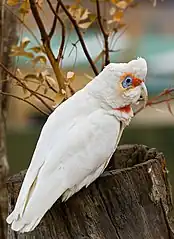| Cacatua[1] | |||||
| Vieillot, 1817[2] | |||||
 Przedstawiciel rodzaju – kakadu cienkodzioba (C. tenuirostris) | |||||
| Systematyka | |||||
| Domena | |||||
|---|---|---|---|---|---|
| Królestwo | |||||
| Typ | |||||
| Podtyp | |||||
| Gromada | |||||
| Podgromada | |||||
| Infragromada | |||||
| Rząd | |||||
| Rodzina | |||||
| Podrodzina | |||||
| Plemię | |||||
| Rodzaj |
Cacatua | ||||
| Typ nomenklatoryczny | |||||
|
Psittacus albus Statius Müller, 1776 | |||||
| |||||
| Gatunki | |||||
| |||||
Cacatua – rodzaj ptaków z podrodziny kakadu (Cacatuinae) w rodzinie kakaduowatych (Cacatuidae).
Zasięg występowania
Rodzaj obejmuje gatunki występujące w Australii, na Nowej Gwinei i okolicznych wyspach, oraz we wschodniej Indonezji i na Filipinach[17].
Morfologia
Długość ciała 30–55 cm; masa ciała 300–975 g[17].
Systematyka
Etymologia
- Cacatua: malaj. nazwa Kakatúa lub Kakak-túa dla kakadu; pochodzenie malajskiej nazwy jest niejasne; kakatuwah „imadło”, w aluzji do potężnego dzioba; „starsza siostra” od kakak „siostra” oraz tua „stary”, w aluzji dla jej hałaśliwych, siostrzanych zachowań[18].
- Kakatoe: niderl. nazwa Kakatoe dla kakadu, od malaj. nazwy Kakatúa „kakadu”[18]. Gatunek typowy: Psittacus philippinarum J.F. Gmelin, 1788 (= Psittacus haematuropygius Statius Müller, 1776).
- Cacatoes: fr. grupowa nazwa Cacatoes dla białych kakadu[18]. Gatunek typowy: Psittacus galeritus Latham, 1790 (Duméril, 1805); Psittacus albus Statius Müller, 1776 (Froriep, 1806); Psittacus sulphureus J.F. Gmelin, 1788 (Boie, 1826).
- Licmetis: gr. λικμητης likmētēs „młynek”, od λικμαω likmaō „przesiewać”[18]. Gatunek typowy: Psittacus tenuirostris Kuhl, 1820.
- Plyctolophus (Pluctolophus, Plyctolophys, Plictolophus): gr. πτυκτος ptuktos „składany”, od πτυσσω ptussō „składać” (por. gr. πλεκω plekō „wyplatać, skręcać”; łac. plicatus „składany”); λοφος lophos „czub”[18]. Gatunek typowy: Psittacus moluccensis J.F. Gmelin, 1788.
- Plissolophus: gr. πλισσομαι plissomai „przejść”; λοφος lophos „czub”[18]. Gatunek typowy: Psittacus moluccensis J.F. Gmelin, 1788.
- Ducorpsius: epitet gatunkowy Cacatua ducorpsii Pucheran, 1853; adiutant Louis Jacques Ducorps (1858), francuski marynarz, intendent, podróżnik[18]. Gatunek typowy: Ducorpsius typus Bonaparte, 1857 (= Cacatua ducorpsii Pucheran, 1853).
- Lophochroa: gr. λοφος lophos „czub”; χροα khroa, χροας khroas „kolor, wygląd”, od χρως khrōs, χρωτος khrōtos „karnacja, cera”[18]. Gatunek typowy: Plyctolophus leadbeateri Vigors, 1831.
- Camptolophus: gr. καμπτος kamptos „elastyczny, zakręcony”, od καμπτω kamptō „zginać”; λοφος lophos „czub”[18]. Gatunek typowy: Psittacus philippinarum J.F. Gmelin, 1788 (= Psittacus haematuropygius Statius Müller, 1776).
- Eucacatua: gr. ευ eu „dobry”; rodzaj Cacatua Vieillot, 1817[18]. Gatunek typowy: Psittacus galeritus Latham, 1790.
Podział systematyczny
Do rodzaju należą następujące gatunki[19]:
- Cacatua leadbeateri (Vigors, 1831) – kakadu ognistoczuba
- Cacatua haematuropygia (Statius Müller, 1776) – kakadu filipińska
- Cacatua goffiniana Roselaar & Michels, 2004 – kakadu białooka
- Cacatua ducorpsii Pucheran, 1853 – kakadu mała
- Cacatua pastinator (Gould, 1841) – kakadu długodzioba
- Cacatua sanguinea Gould, 1843 – kakadu sinooka
- Cacatua tenuirostris (Kuhl, 1820) – kakadu cienkodzioba
- Cacatua alba (Statius Müller, 1776) – kakadu biała
- Cacatua ophthalmica P.L. Sclater, 1864 – kakadu niebieskooka
- Cacatua moluccensis (J.F. Gmelin, 1788) – kakadu molucka
- Cacatua sulphurea (J.F. Gmelin, 1788) – kakadu żółtolica
- Cacatua galerita (Latham, 1790) – kakadu żółtoczuba
Przypisy
- ↑ Cacatua, [w:] Integrated Taxonomic Information System (ang.).
- ↑ L.J.P. Vieillot: Kakatoés. W: Nouveau dictionnaire d’histoire naturelle, appliquée aux arts, à l’agriculture, à l’économie rurale et domestique, à la médecine, etc.. Wyd. 2. T. 17. Paris: Chez Deterville, 1817, s. 6. (fr.).
- ↑ G. Cuvier: Lecons d’anatomie comparée. Paris: Baudouin, Imprimeur de l’Institut National des Sciences et des Arts, 1800, s. tab. 2. (fr.).
- ↑ A.M.C. Duméril: Zoologie analytique, ou, Méthode naturelle de classification des animaux: rendue plus facile a l’aide de tableaux synoptiques. Paris: Allais, libraire, 1805, s. 50. (fr.).
- ↑ L.F. von Froriep: C. Dumeril’s, Doctors und Professors an der medicinischen Schule zu Paris, Analytische Zoologie. Weimer: Im Verlage des Landes-Industrie-Comptoirs, 1806, s. 51. (niem.).
- ↑ L.J.P. Vieillot: Analyse d’une nouvelle ornithologie élémentaire. Paris: Deteville, libraire, rue Hautefeuille, 1816, s. 26. (fr.).
- ↑ F. Boie. Generalübersicht der ornithologischen Ordnungen, Familien und Gattungen. „Isis von Oken”. Jahrgang 1826 (1), s. 977, 1826. (niem. • łac.).
- ↑ J.G. Wagler. Conspectus systematicus generum et specierum ex ordine Psittacorum, adjectis generum characteribus. „Abhandlungen der Mathematisch-Physikalischen Klasse der Königlich Bayerischen Akademie der Wissenschaften”. 1, s. 505, 1832. (łac.).
- ↑ Ch.L. Nitzsch: System der Pterylographie. Nach seinen handschriftlich aufbewahrten Untersuchungen verfasst. Halle: E. Anton, 1840, s. 146. (niem.).
- ↑ C.W.L. Gloger: Gemeinnütziges Hand- und Hilfsbuch der Naturgeschichte. Breslau: A. Schulz, 1841, s. 193. (niem.).
- ↑ H. Burmeister: Verzeichnis der im zoologischen Museum der Universität Halle-Wittenberg aufgestellten Säugethiere, Vögel und Amphibien. Halle: W. Plötz, 1850, s. 59. (niem.).
- ↑ Bonaparte 1857 ↓, s. 534.
- ↑ Bonaparte 1857 ↓, s. 537.
- ↑ O. Finsch: Die Papageien, monographisch bearbeitet. Cz. 1. Leiden: Brill, 1867, s. 265. (niem.).
- ↑ C.J. Sundevall: Methodi naturalis avium disponendarum tentamen. Försök till fogelklassens naturenliga uppställnung. Stockholm: Samson & Wallin, 1872, s. 69. (łac.).
- ↑ G.M. Mathews: The birds of Australia. Cz. 6. London: H.F. & G. Witherby, 1917, s. 169. (ang.).
- 1 2 D.W. Winkler, S.M. Billerman & I.J. Lovette: Cockatoos (Cacatuidae), version 1.0. W: S.M. Billerman, B.K. Keeney, P.G. Rodewald & T.S. Schulenberg (red.): Birds of the World. Ithaca, NY: Cornell Lab of Ornithology, 2020. DOI: 10.2173/bow.cacatu2.01. [dostęp 2020-10-18]. (ang.).

- 1 2 3 4 5 6 7 8 9 10 Etymologia za: The Key to Scientific Names, J.A. Jobling (red.), [w:] Birds of the World, S.M. Billerman et al. (red.), Cornell Lab of Ornithology, Ithaca (ang.).
- ↑ Systematyka i nazwy polskie za: P. Mielczarek & M. Kuziemko: Plemię: Cacatuini Gray,GR, 1840 (1825) (wersja: 2022-09-14). [w:] Kompletna lista ptaków świata [on-line]. Instytut Nauk o Środowisku Uniwersytetu Jagiellońskiego. [dostęp 2022-10-07].
Bibliografia
- Ch.L. Bonaparte. Des observations de M. Emile Blanchard sur les caracteres osteologiques chez les Oiseaux de la famille des Psittacides. „Comptes Rendus Hebdomadaires des Séances de l’Académie des Sciences”. 44, s. 534–539, 1857. (fr.).
This article is issued from Wikipedia. The text is licensed under Creative Commons - Attribution - Sharealike. Additional terms may apply for the media files.